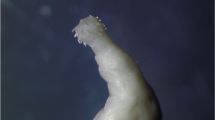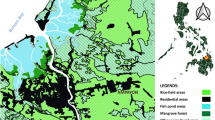Abstract
Purpose
The present study aimed to record the prevalence, risk factors, molecular identification, and phylogeny of Nippostrongylus brasiliensis found in the small intestine of the lesser bandicoot rat, Bandicota bengalensis, a wild rodent species.
Methods
A total of 100 bandicoot rats live trapped at two commensal urban locations (50 each), i.e., a fish market and railway station, in Ludhiana, Punjab State (India), from November 2020 to October 2021, were analysed for the presence of N. brasiliensis, a nematode parasite of zoonotic importance.
Result
Overall, the small intestine of 43.00% of the rats was found severely infected with bright red coloured adult N. brasiliensis of both sexes (total of 1439 specimens). Faecal samples contained ellipsoidal and thin-shelled eggs measuring 62.25–74.70 m in length and 33.20–37.35 m in breadth. No significant (P > 0.05) effect of host age, sex, or season was observed on the rate of infection. The parasite intensity and mean abundance ranged from 27.68–38.04 and 10.52–18.26, respectively, indicating a high risk of disease transmission. Based on the morphology, the nematode parasite was identified as Nippostrongylus sp. Molecular identification was confirmed through PCR amplification of the mitochondrial cytochrome oxidase I gene, which showed a single band of approximately 355 bp. A comparison of the present isolate with the available sequences of Nippostrongylus species across the globe showed 100% nucleotide homology with N. brasiliensis sequences available in GenBank from Japan (AP017690), the USA (U57035), and New Zealand (NC033886).
Conclusion
The study indicates that B. bengalensis inhabiting commensal urban areas is a reservoir host for N. brasiliensis, which if transmitted to humans and animals visiting the area may pose a potential health risk. The study thus suggests proper rodent population management close to human habitations to avoid the transmission of disease-causing agents.




Similar content being viewed by others
Availability of Data and Material
None.
Code Availability
None.
References
Garedaghi Y, Khaki AA (2014) Prevalence of gastrointestinal and blood parasites of rodents in Tabriz, Iran, with emphasis on parasitic zoonoses. Cres J Med Biol Sci 1:9–12
Han BA, Schmidt JP, Bowden SE, Drake JM (2015) Rodent reservoirs of future zoonotic diseases. Proc Natl Acad Sci, USA 112:7039–7044. https://doi.org/10.1073/pnas.1501598112
Belmain SR (2006) Rats and Human Health in Africa. Proceedings of an International Workshop on Rodent-borne Diseases and the RatZooMan Research Project. Malelane, South Africa.
Himsworth CG, Parsons KL, Jardine C, Patrick DM (2013) Rats, cities, people, and pathogens: a systematic review and narrative synthesis of literature regarding the epidemiology of rat-associated zoonoses in urban centers. Vector Borne Zoonotic Dis 13(6):349–359
Sidhu A, Singla N, Lonare M, Mahal AK (2020) Effect of quinestrol on body weight, vital organs, biochemicals and genotoxicity in adult male lesser bandicoot rat, Bandicota bengalensis. Pestic Biochem Physiol. https://doi.org/10.1016/j.pestbp.2020.02.010
Brar SK, Singla N, Singla LD (2021) Comparative comprehensive analysis on natural infections of Hymenolepis diminuta and Hymenolepis nana in commensal rodents. Helminthologia 58:248–262. https://doi.org/10.2478/helm-2021-0027
Singla LD, Singla N, Parshad VR, Juyal PD, Sood NK (2008) Rodents as reservoirs of parasites in India. Integr Zool 3:21–26. https://doi.org/10.1111/j.1749-4877.2008.00071.x
Singla N, Dhar P, Singla LD, Gupta K (2016) Patho-physiological observations in natural concurrent infections of helminth parasites of zoonotic importance in the wild rodents, Bandicota bengalensis. J Parasit Dis 40:1435–1442. https://doi.org/10.1007/s12639-015-0709-6
Brar SK, Singla N, Singla LD (2021) Molecular characterization and histo-physiological alterations induced by concurrent helminthosis in the liver of urban commensal rodents in Punjab, India. Iranian J Vet Res 22:15–23. https://doi.org/10.22099/ijvr.2020.38050.5539
Swain K, Routray A, Panigrahi S, Rath A, Sahoo S, Ganguly S (2016) Nippostrongylus brasiliensis, an experimental model: a review. Int J Contemp Pathol 2(2):36. https://doi.org/10.5958/2395-1184.2016.00031.0
Mandla D, Singla N, Brar SK, Singla LD (2022) Diversity, prevalence and risk assessment of nematode parasites in Tatera indica found in Punjab State. Indian J Anim Res 56(6):736–741. https://doi.org/10.18805/IJAR.B-4369
Soulsby EJL (1982) Helminths, Arthropods and protozoa of domesticated animals, 7th edn. Balliere Tindall, London. https://doi.org/10.1016/0035-9203(84)90110-X
Taylor MA, Coop RL, Wall RL (2016) Veterinary parasitology, 4th edn. Wiley Blackwell, UK. https://doi.org/10.1002/9781119073680
Bush A, Lafferty K, Lotz J, Shostak A (1997) Parasitology meets ecology on its own terms: Margolis et al. Revisited J Parasitol 83:575–558
Hasegawa M, Kishino H, Yano T (1985) Dating the human-ape split by a molecular clock of mitochondrial DNA. J Mol Evol 22:160–174. https://doi.org/10.1007/BF02101694
Kumar S, Stecher G, Li M, Knyaz C, Tamura K (2018) MEGA X: Molecular evolutionary genetics analysis across computing platforms. Mol Biol Evol 35:1547–1549. https://doi.org/10.1093/molbev/msy096
Thrusfield M (ed) (2005) Veterinary epidemiology, 2nd edn. Blackwell Science Ltd., UK, p 243
Shafiyyah COS, Jamaiah I, Rohela M, Lau YL, Aminah FS (2012) Prevalence of intestinal and blood parasites among wild rats in Kuala Lumpur, Malaysia. Trop Biomed 29(4):544–550
Musyaffa MF, Dewi K, Supriatna N (2020) Nematoda parasit pada Rattus spp. dari Pulau Simeulue, Aceh. J Biologi Papua 12(1):1–9. https://doi.org/10.31957/jbp.882
Coomansingh C, Vishakha V, Montanez AA, Armstrong E, Sharma RN (2019) Internal parasitic burdens in brown rats (Rattus norvegicus) from Grenada West Indies. Heliyon 5(8):1–5
DeFranco AL, Locksley R, Robertson M (2007) Immunity: the immune response in infectious and inflammatory disease, 1st edn. The New Science Press, London, pp 274–275
Kia EB, Shahryary-Rad E, Mohebali M, Mahmoudi M, Mobedi I, Zahabiun F et al (2010) Endoparasites of rodents and their zoonotic importance in Germi, Dashte-Mogan, Ardabil Province, Iran. Iranian J Parasitol 5:15–20
Kataranovski M, Mirkov I, Belij S, Popov A, Petrovic Z, Gacic Z et al (2011) Intestinal helminths infection of rats (Rattus norvegicus) in the Belgrade area (Serbia): the effect of sex, age and habitat. Parasitology 18:189–196. https://doi.org/10.1051/parasite/2011182189
Chaudhary A, Goswami U, Khatoon HS (2016) Molecular characterization of Nippostrongylus brasiliensis (Nematoda: Heligmosomatidae) from Mus musculus in India. Korean J Parasitol 54:743–750. https://doi.org/10.3347/kjp.2016.54.6.743
Julius RS, Schwan EV, Chimimba CT (2017) Helminth composition and prevalence of indigenous and invasive synanthropic murid rodents in urban areas of Gauteng Province, South Africa. J Helminthol 4:1–10. https://doi.org/10.1017/S0022149X17000761
Camberis M, Le Gros G, Urban J Jr (2003) Animal model of Nippostrongylus brasiliensis and Heligmosomoides polygyrus. Curr Protoc Immunol. https://doi.org/10.1002/0471142735.im1912s55
Marsland BJ, Kurrer M, Reissmann R, Harris NL, Kopf M (2008) Nippostrongylus brasiliensis infection leads to the development of emphysema associated with the induction of alternatively activated macrophages. European J Immunol 38:479–488
Mercer JG, Mitchell PI, Moar KM, Bissett A, Geissler S, Bruce K, Chappell LH (2000) Anorexia in rats infected with the nematode, Nippostrongylus brasiliensis: experimental manipulations. Parasitology 120:641–647
Acknowledgements
The authors are thankful to the Indian Council of Agricultural Research, New Delhi, India for providing financial assistance in the form All India Network Project on Vertebrate Pest Management and Department of Science & Technology, New Delhi, India for providing laboratory infrastructure in the form of FIST (Fund for Improvement of S&T Infrastructure) project at Punjab Agricultural University, Ludhiana, India.
Funding
The study was funded by the Indian Council of Agricultural Research, New Delhi, India in the form of All India Network Project on Vertebrate Pest Management at Punjab Agricultural University, Ludhiana, Punjab, India.
Author information
Authors and Affiliations
Contributions
The study was conceived and designed by Dr. Neena Singla and Ms. Shivani Rara. Material preparation and data collection were performed by Ms. Shivani Rara. Dr Sukhmanpreet Kaur Brar and Ms. Dimple Mandla assisted in laboratory work. Work was supervised by Dr. Neena Singla and Dr. Lachhman Das Singla. Data were analysed by Ms. Shivani Rara, Dr. Neena Singla and Ms. Dimple Mandla. The first draft of the manuscript was written by Ms. Sukhmanpreet Kaur Brar. The manuscript was reviewed and edited by Dr. Neena Singla and Dr. Lachhman Das Singla. Funds were acquired by Dr. Neena Singla. All authors read and approved the final manuscript.
Corresponding author
Ethics declarations
Conflict of Interest
The authors declare that they have no conflict of interest.
Ethics Approval
Approval was obtained from Institutional Animal Ethics Committee of Guru Angad Dev Veterinary and Animal Sciences University (GADVASU), Ludhiana, India for use of animals under Protocol no. GADVASU/2018/IAEC/46/16. The procedures used in this study adhere to the guidelines of Committee for the Purpose of Control and Supervision of Experiments on Animals, India.
Consent to Participate
Not applicable.
Consent for Publication
Not applicable.
Additional information
Publisher's Note
Springer Nature remains neutral with regard to jurisdictional claims in published maps and institutional affiliations.
Rights and permissions
Springer Nature or its licensor (e.g. a society or other partner) holds exclusive rights to this article under a publishing agreement with the author(s) or other rightsholder(s); author self-archiving of the accepted manuscript version of this article is solely governed by the terms of such publishing agreement and applicable law.
About this article
Cite this article
Rara, S., Singla, N., Brar, S.K. et al. Severe Infection of Nippostrongylus brasiliensis in Bandicota bengalensis Inhabiting Commensal Areas of Punjab, India: Prevalence, Risk Factor Analysis, Molecular Identification and Phylogenesis. Acta Parasit. 68, 172–181 (2023). https://doi.org/10.1007/s11686-022-00652-z
Received:
Accepted:
Published:
Issue Date:
DOI: https://doi.org/10.1007/s11686-022-00652-z




